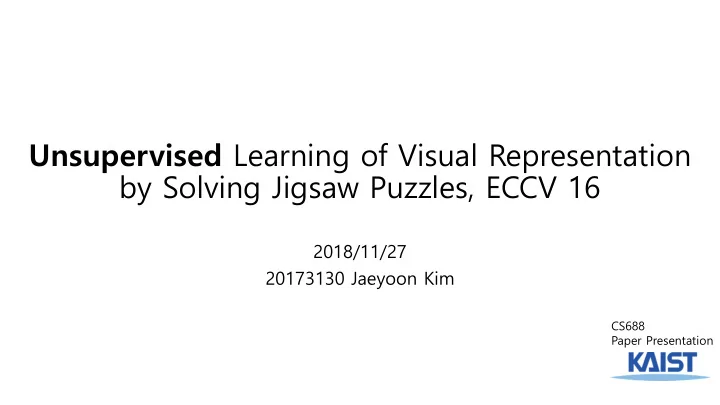

Unsupervised Learning of Visual Representation by Solving Jigsaw Puzzles, ECCV 16 2018/11/27 20173130 Jaeyoon Kim CS688 Paper Presentation
Image Retrieval with Mixed initiative and Multimodal Feedback, BMVC ’18 • The system based on reinforcement learning chooses an action and let users answer their need or draw a sketch. • The system Iteratively performs the action selection and finally gets adaptive retrieval result to users. 2
Table of Contents • Introduction • Relationship with Image Retrieval • Context prediction task(relative position) • Its limitation • Main Idea • Experiment & Result 3
Introduction - Relationship with Image Retrieval - Context prediction task(relative position) - Its limitation 4
Relationship with Image Retrieval • In the class, we also saw performance improvement when fine-tuning with specific dataset. • For fine-tuning with specific dataset, labels are necessary since it is performed in a supervised manner. • Therefore, this unsupervised technique will be useful to cheap fine-tuning for image retrieval. Figure in the class… 5
Context Prediction, ICCV ‘15 Classifier CNN CNN Randomly Sample Patch Sample Second Patch 6
Critical Problem of Context Prediction • If only two tiles are given, the machine might suffer from an ambiguity. • Can you answer only if the blow blue and red patches are given? • There might be ambiguity . • As its negative effect, it takes 4 weeks to train the network with the task. -> very slow! ? ? ? ? ? , ? ? ? 7
Main Idea 8
What is jigsaw puzzle? • The task is to separate an object into several puzzles and put the puzzles together. • It was introduced as a pretext task to help children learn geography. 9
An example of this task 1. Sample 9 neighbor tiles - figure (a). 2. Obtain a puzzle by randomly shuffling the sampled tiles – figure (b). 3. Determine all positions of the shuffled tiles - figure (c). -> This work is less ambiguous , compared to previous method since all patches are given to network. 10
Problem formulation as classification • Given 9 tiles, there are 9! = 362,880 possible permutations. • Due to too many possible permutation (classes), They quantize the possible permutation into 64 classes .
Problem formulation as classification • The network takes 9 tiles as an input in a siamese manner • And it predicts a specific sequence among 64 classes. • Generate classification loss and update the network via backpropagation
Experiments & Results 13
Transfer learning for evaluation • They use the feature extractor which is in below red box for evaluating the network. • They perform transfer learning for each task such as classification, detection and semantic segmentation. Feature extractor 14
Results on PASCAL VOC 2007 • They fine-tuned the pre-trained network with PASCAL VOC training data. • Blue box is a supervised method and red box is Context Prediction method. • This method is much superior to Context Prediction in terms of pre-training time as well as accuracy thanks to less ambiguity of the task. 15
Visualization of top activations • We can see that the network is able to capture semantic information as going to higher layer even though any semantic label is not given during training. 16
Image Retrieval Results • They found nearest neighbor results on the PASCAL VOC dataset query Supervised method This method Random weight 17
Thank you!! 18
Recommend
More recommend